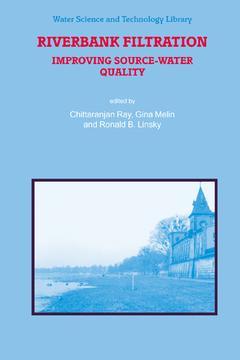Riverbank Filtration, 2003 Improving Source-Water Quality Water Science and Technology Library Series, Vol. 43
Langue : Anglais
Coordonnateurs : Ray C., Melin G., Linsky R.B.

Chittaranjan Ray, Ph. D. , P. E. University of Hawaii at Mãnoa Honolulu, Hawaii, United States Jürgen Schubert, M. Sc. Stadtwerke Düsseldorf AG Düsseldorf, Germany Ronald B. Linsky National Water Research Institute Fountain Valley, California, United States Gina Melin National Water Research Institute Fountain Valley, California, United States 1. What is Riverbank Filtration? The purpose ofthis book is to show that riverbank filtration (RBF) isa low-cost and efficient alternative water treatment for drinking-water applications. There are two immediate benefits to the increased use of RBF: Minimized need for adding chemicals like disinfectants and coagulants to surface water to control pathogens. Decreased costs to the community without increased risk to human health. Butwhat,exactly, isRBF? In humid regions, river water naturally percolates through the ground into aquifers (which are layers of sand and gravel that contain water underground) during high-flow conditions. In arid regions, most rivers lose flow, and the percolating water passes through soil and aquifer material until it reaches the water table. During these percolation processes, potential contaminants present in river water are filtered and attenuated. If there are no other contaminants present in the aquifer or ifthe respective contaminants are present at lower concentrations, the quality of water in the aquifer can be ofhigher quality than that found in theriver. In RBF, production wells ? which are placed near the banks ofrivers ?pump large quantities ofwater.
Introduction; C. Ray, P.E., J. Schubert, R.B. Linsky, G. Melin. What is Riverbank Filtration? Historical Significance. Unrecognized RBF Plants. Similarities Between RBF and Slow Sand Filtration. Surface-Water Contaminants of Concern. Case Studies of Log Removal Credit in the United States. The Value of Applying RBF as a Pretreatment Technology. Part I: Systems. 1: Conceptual Design of Riverbank Filtration Systems; H. Hunt, J. Schubert, C. Ray. Introduction. Well Types and the Suitability of Vertical Versus Horizontal Collector Wells. Evolution of the Design of Horizontal Collector Wells. 2: American Experience in Installing Horizontal Collector Wells; H. Hunt. Introduction. Timeline. Historical Progression. Collector Well Construction. Hydrogeological Investigation/Testing. Design and Construction Details. 3: German Experience with Riverbank Filtration Systems; J. Schubert. River Characteristics for Siting RBF. Flow Dynamics of Rivers and River/Aquifer Interaction. Field Studies on RBF - Hydraulic Aspects. 4: Riverbank Filtration Construction Options Considered at Louisville, Kentucky; S. Hubbs, K. Ball, D.L. Haas, M.J. Robison. Introduction. Soft-Soil Tunnel Option.Hard-Rock Tunnel Option with Horizontal Collector Wells. Hard-Rock Tunnel Option with Vertical Wells. Conventional Collector Well Design. Construction Cost Estimate Notes. Evaluation of Alternatives. 5: Operation and Maintenance Considerations; H. Hunt, J. Schubert, C. Ray. Introduction. Select Operating Wells in the United States. Select Operating Wells in Germany. Other Applications. Conclusion. Part II: Contaminant Removal. 6: Removal of Pathogens, Surrogates, Indicators, and Toxins Using Riverbank Filtration; J. Schijven, P. Berger, I. Miettinen. Introduction. Why RBF for Microbial Pathogens? Pathogen Occurrence in Surface Water. Health Effects. Outbreaks Related to the Use of Riverbank-Filtered Drinking Water. Required Treatment of Surface Water for Drinking-Water Production in the United States, Finland, and The Netherlands: Implications for RBF Treatment. Hydrology and Hydrogeology. Microorganism Removal by RBF: Processes. Surrogate Microorganisms and Other Indicators. Removal by RBF and Artificial Infiltration. Cyanobacteria (Blue-Green Algae). Conclusions. 7: Riverbank Filtration Case Study at Louisville, Kentucky; J. Wang. Introduction. Previous Studies Conducted at Louisville, Kentucky. Description of the RBF Facility. Determination of Water Time Travel and Groundwater Dilution. NOM and Disinfection Byproduct Precursor Removal. Removal of Microbial Contaminants. Summary. 8: Reduction in Disinfection Byproduct Precursors and Pathogens During Riverbank Filtration at Three Midwestern United States Drinking-Water Utilities; W.J. Weiss, E.J. Bouwer, W.P. Ball, C.R. O'Melia, H. Arora, T.F. Speth. Introduction. Site Descriptions. Inorganic Monitoring. Microbial Monitoring. Disinfection Byproduct Formation Potential Testing. Simulated Conventional Treatment. Uniform Formation Conditions Testing. Risk Calculations for Disinfection Byproduct Formation Data. Conclusions. 9: Occurrence, Characteristics, Transport, and Fate of Pesticides, Pharmaceuticals, Industrial Products, and Personal Care Products at Riverbank Filtration Sites; I.M. Verstraeten, T. Heberer, T. Scheytt. Introduction. Phys
Date de parution : 12-2003
Ouvrage de 366 p.
15.5x23.3 cm
Date de parution : 03-2003
Ouvrage de 366 p.
15.5x23.5 cm
© 2024 LAVOISIER S.A.S.



